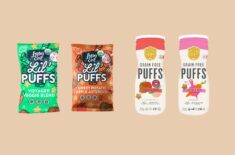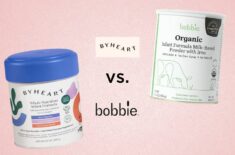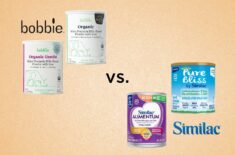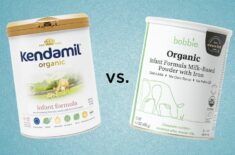Overview
According to the child development milestones of the AAP (American Academy of Pediatrics), most babies begin to use objects (such as drinking from a cup) by their first birthday. (1)
The timeline of a baby’s development can vary among kids, but they’re expected to use utensils such as a spoon and fork by their fifth birthday, according to the AAP’s milestones. (1)
Although the AAP’s child development milestone list doesn’t indicate when babies are expected to start learning to use a spoon and fork, many parents introduce them to utensils when they’re around 6-12 months of age.
Still, even if kids develop at varied rates, the Child Mind Institute considers it a red flag if your baby still doesn’t seem to know the function of common household items such as a spoon and fork by 15 months. (2)
So, when should you introduce utensils to your baby, which ones are they supposed to use first, and how will you know if they’re ready?
Let’s discuss the answers to these questions below.
Is Your Baby Ready For Spoons & Forks?
Of course, it’s important to determine that your baby is ready for solid foods before introducing them to spoons and forks.
Once they’re ready and you’ve introduced their first foods, then you can let your baby learn how to use feeding utensils.
Most babies are still learning how to use their hands and coordinate their movements around the time they start eating solid foods.
If you’re following the BLW (baby-led weaning) approach, you’ll notice that your baby starts grabbing food with their entire palm. This is the palmar grasp.
Some spoons, such as the Bumkins Silicone Chewtensils or UpwardBaby BLW Feeding Supplies, have a rounded, short handle. Spoons like these are ideal because your baby’s entire palm can curl around the handle.
It’s alright to give your baby utensils when they start eating solids. However, you can’t actually expect them to know how to pick these up and put them in their mouths at this stage.
These are some of the things to consider before introducing cutlery to your baby:
Check For Signs of Readiness
Babies ready for utensils often show curiosity about how adults and older children use silverware during mealtimes.
Although some moms might hold off the utensils until their baby has mastered the pincer grasp (picking up bite-sized food pieces with their thumb and index finger), you can also follow your baby’s lead.
If you’ve been pre-loading their spoons, your baby might begin grabbing your hand or the utensil to try and feed themselves.
Some young children might not even appreciate a pre-loaded spoon because they’d rather scoop the food themselves.
In both cases, you can let your baby improve their feeding skills by giving them a spoon.
We know that learning this new skill can be messy, mama. Your little one is likely to send most of the food to the floor or on themselves in the first few days or weeks.
Thankfully, things will improve as they improve their hand-eye coordination, fine motor skills, and feeding skills.
Abilities Required For Independent Eating & Using Utensils
In comparing BLW vs. spoon-feeding with purées, you’ll notice that babies might require different sets of abilities or skills for each feeding approach.
For example, spoon-fed infants don’t require hand-eye coordination during mealtimes.
However, if you want your baby to learn how to become an independent eater, you can start by letting them learn to feed themselves.
Babies need to develop these abilities for effective and safe independent eating:
- Chewing their food
- Swallowing the chewed food and getting ready for the next bite
- Ability to hold a spoon or other utensils
- Hand-eye coordination to get the spoon (or pre-spoon) in the bowl or plate
- Fine motor skills to scoop some baby food
- Hand-eye coordination to move the spoon from the bowl or plate to their mouth
- Maintaining an upright sitting position throughout the meal
When To Introduce Utensils To Your Baby
Your little one will pick up baby utensils and use these when they’re ready. You can introduce them to these feeding utensils as soon as you start them on solid foods.
However, you don’t have to force them to use the utensils if they ignore, play, or throw these things away.
Check for the signs of readiness mentioned above, but keep trying every mealtime until your baby understands that they need these utensils during meals.
Which Utensil Should I Offer First: Spoon Or Fork?
From a safety standpoint, it’s best to introduce spoons first. They’re rounded, smooth, and don’t have potentially sharp, pointy spears like the fork.
By choosing the spoon, you can let your baby learn how to use cutlery without fear of accidentally stabbing their sensitive gums or other parts of their face.
When Can I Introduce A Spoon To My Baby?
A spoon can be a handy tool for your baby when they start eating at around six months of age. However, if they don’t seem interested, you can wait until they’re around 7-8 months old before trying again. (3)(4)
But even if they’re interested, your little one isn’t likely to develop dexterity and skills to hold a spoon properly at around 4-6 months.
They can practice hand-eye coordination with finger foods on their high chair tray or a child-safe plate and bowl.
Most babies are likely to show interest in using utensils by their first birthday or around 8-12 months old.
When Should I Introduce A Knife & Fork To My Baby?
Even soft silicone forks and plastic knives can still have the potential to hurt your little one if they accidentally move these to their eyes.
It’s best to hold off introducing the knife and fork when your baby has already mastered using the spoon.
Most kids might be ready for a fork when they’re around 15-16 months old, yet aren’t likely to master it by 17-18 months. But always watch your child during mealtimes, especially when they’re still trying to learn how to use a fork. (4)(5)
It can be a good idea to wait until they’re at least two or even three years old before giving them a knife. Ensure that it’s a dull knife without sharp, pointed tips.
When Can Babies Use Metal Utensils?
Due to their soft, sensitive gums and mouths, your baby might potentially hurt themselves while self-feeding using metal utensils.
So, it’s good to wait until they’re around 18 months old before introducing them to metal utensils such as silverware or stainless steel cutlery.
When Can Babies Use A Cup?
Babies can begin drinking from a cup at around six months of age. Start with a small amount of liquid in a baby-sized cup, but make sure to hold the cup and guide them while they’re drinking.
Expected Timeline & Self-Feeding Milestones
When Do Babies Begin To Master Utensil Use?
According to the AAP, most kids are expected to master using a fork and spoon by the time they’re five years old. (1)
However, many kids master these skills at a much younger age.
Fingers
Finger-feeding mastery can be considered a prerequisite for learning how to use utensils.
If you start them early at around 4-6 months of age, when they show readiness for solid foods, they can master their hand-eye coordination and feed themselves by 8-10 months.
Spoons
Mastering the spoon depends on many factors, including:
- When they start using the utensil
- What type of utensils they’re using
- The practice time they get with using these tools
Those who start early might already master spoon-feeding themselves at around 12-15 months old, while others could be around two years old.
Don’t worry if your baby doesn’t appear interested in using utensils because kids develop at different rates.
Forks
Because they usually start with forks later than spoons, babies are likely older than two years old before they master using this utensil.
Cups
When introduced to a baby cup at around six months old, babies can master using this utensil by their first birthday.
Different Development Stages Of Your Self-Feeding Baby (Using Utensils)
Babies don’t need to follow a specific order of which foods to eat and utensils to use. However, many will follow these developmental feeding milestones: (4)(6)
- Maintains upright sitting posture at mealtimes
- Tolerates new tastes and textures in eating solid foods (with spoon-feeding or baby-led-weaning)
- Grasp utensils
- Self-feeds with a utensil, such as a pre-spoon (parent might feed most of the meal for spoon-fed babies)
- Self-feeds with a spoon using a hand-over-hand guide
- Independently self-feeds “sticky foods” like yogurts and mashed potatoes
- Independently self-feeds most foods, including soups
- Self-feeds with a spoon while parent feeds using a fork
- Self-feeds with a fork using a hand-over-hand guiding
- Independently self-feeds using a fork
- Independently self-feeds using a spoon, fork, and knife
Choosing The Right Utensils For Your Baby
The right utensils can help your baby eat safely, learn proper table manners, and easily master how to use them.
What to Look For When Picking Your Baby’s Utensils
- Silicone utensils are preferable, especially for younger children, because these are soft and less likely to hurt your baby’s soft gums.
- When choosing plastic utensils, check for BPA-free (bisphenol-A) options.
- Check for potential safety hazards in the utensils’ design.
- Always check for product recalls or safety alerts for each product you’re planning to purchase.
Spoons & Forks
Choosing Mini Spoons & Forks
Regular-sized cutlery is too big for your baby’s mouth.
Utensils designed for babies aren’t just small but also consider their safety. For example, less sharp, round-edged toddler forks help ensure they don’t get punctured by the tips.
Best Baby Spoons & Forks (By Age)
4 to 6+ Months
- Pick spoons with small and soft silicone tips.
- Spoons with shorter handles are preferable for self-feeding babies.
- Spoons with longer handles are for parents to spoon-feed their babies.
- Prespoons have a flat tip designed for babies to use any side up.
Examples of pre-spoons:
- NumNum Pre-Spoon Gootensils
- eZtotZ Little Dippers Self Feeding Starter Spoon
7 to 8+ Months: The Best Baby-Led Weaning Spoons
For babies starting to learn how to self-feed, utensils with rounded, short handles might be easier to hold.
For babies younger than one year old, cutlery with choke guards can be the better choice.
Some of the best baby-led weaning spoons include:
- Munchkin Gentle Scoop Silicone Trainer Spoon
- GrabEASE Double Silicone Spoons
- Bumkins Silicone Chewtensils
- UpwardBaby BLW Feeding Supplies
9 to 10+ Months
As they master their feeding skills and outgrow the palmar grasp, babies slowly get ready for spoons with regular, flat handles. However, it’s still best to pick baby spoons because they have smaller, softer heads.
It’s still a good idea to pick spoons with a soft, silicone head.
Examples can include:
- Beaba Baby’s First Foods Silicone Spoon
- Munchkin White Hot Safety Spoons
18+ Months
Older toddlers can start using silverware and stainless steel spoons.
Examples can include:
- Avanchy Stainless Steel Baby Spoons
- NUK Kiddy Cutlery Set
- Green Sprouts Learning Cutlery Set
Plates & Bowls
Plates and bowls with a suction base are more likely to stay in place. Silicone or stainless steel plates are preferable.
Examples can include:
- Loulou Lollipop Silicone Suction Snack Plate
- Ahimsa Balanced Bites Stainless Steel Plates
Cups
- Tiny cups that are narrow enough for little hands to hold
- Cups with a topple-resistant base can help reduce spills
Examples can include:
- EZPZ Tiny Cup
- Munchkin Miracle 360 Trainer Cup
Reasons To Avoid Sippy Cups
Many parents prefer to give liquids to their babies using straw or sippy cups rather than a standard or baby cup.
However, it’s best to ask your pediatrician’s advice about using sippy cups because some experts advise against using them.
Feeding specialist and speech-language pathologist Melanie Potock, MA, of ASHA (American Speech-Language-Hearing Association), explains why parents should skip sippy cups in favor of standard cups. (7)
According to Potock, the hard spout of the sippy cup can interfere with your baby’s tongue development. In turn, this could affect your baby in several ways:
Swallowing Patterns
Babies start with the suckle-swallow pattern but eventually develop mature swallowing patterns.
However, sippy cups can delay this development, making it difficult for them to chew and swallow new foods. (7)
Speech & Language Development
Potock explains that kids begin to develop mature swallowing skills and ditch the suckle-swallow pattern at around 6-12 months of age. (7)
When kids are introduced to sippy cups or continue to use pacifiers at this age, their oral development can be affected. This could also impede their speech and language development.
Proper Facial Development
Babies who use pacifiers and sippy cups tend to have tongues that rest forward, so their mouths tend to stay open.
This kind of tongue and mouth position can hinder proper facial development, leading to mouth breathing and lowering of the jaw muscles. (7)
How Do I Start My Baby On Utensils?
Where To Start: Finger Feeding
Finger feeding helps them develop and master hand-eye coordination.
Choose The Best Foods For Introducing Utensils
Pick foods that are easier to scoop with a spoon or stab with a fork.
Some examples of spoon-friendly baby foods:
- Mashed potatoes
- Mashed sweet potatoes
- Mashed avocados or guacamole
- Hummus
- Oatmeal
- Thick puréed soups
Fork-friendly baby foods:
- Pasta shells
- Soft fruits like mangoes, melons, or bananas
- Pancake squares
- Whole grain toast squares
SAFETY WARNING: Cut fruits and other food into age-appropriate bite-sized, smaller pieces to reduce choking risks.
Pick The Right Time
Start offering utensils when your child shows interest or readiness to use them.
Try not to force your child to use utensils if they keep throwing them away.
Start With Just The Spoon
Hand-Over-Hand Method
Many parents find the hand-over-hand effective.
Just put your hand over your toddler’s hand, then guide them in scooping the food and slowly putting it in their mouth.
Preloading The Spoon (Or Pre-spoon)
You can also put food on the spoon or pre-spoon, then let your baby pick it up and put the food in their mouth.
Be Your Baby’s Role Model
Another way to teach them is to let them copy your movements while you use your own spoon.
Next In Line: Introduce the Fork
Once they master the spoon, you can begin introducing them to the fork using the training methods you use for the spoon.
Fingers & Cutlery Are Fine
There’s no need to rush your little one into mastering their feeding skills.
If they still use their fingers or even pick up the food with their hands, that’s fine. They’ll eventually learn to get the hang of it.
Last On Your Utensil List: Introducing A Knife
It can take time before your baby will master using a knife, but you can also similarly teach them as you did with the spoon and fork.
Minimizing The Mess
Mealtimes can be messy when your child is still learning to feed themselves. Using bibs or putting sheets under the high chair can make clean-ups easier.
Self-Feeding Practice Makes Perfect
It takes time for any baby to master their cutlery use. Let them practice as much as they could every mealtime. There’s no need to rush.
What’s Next For Your Baby?
Once they’ve mastered cutlery use and self-feeding, it might be time for them to move from their high chair to a booster chair at the table.
This can help them further enhance their skills through practice and observing older children and adults eat.
FAQs
Can You Spoon Feed A 4-Month-Old?
Yes. A lot of parents prefer spoon-feeding their babies, but make sure your child already shows signs of readiness for solid foods.
Consult your pediatrician before giving solid foods to babies younger than six months of age.
What’s Baby-Led Weaning?
BLW (baby-led weaning) is a feeding approach that encourages your little ones to feed themselves and direct their mealtime experiences.
They get to pick the foods they want from the ones you prepared, eat as little or as much as they want to, and stop anytime they want.
BLW can help prevent your baby from becoming a picky eater. (8)
At What Age Do Babies Say Their First Word?
Babies don’t start talking at the same age, but most will say their first word within their first year of life.
Their speech can be affected by several factors, including the use of pacifiers and sippy cups, as explained above. (7)
REFERENCES
(1) https://aapdc.org/wp-content/uploads/2014/01/Early-Stages-Milestones-EN-2011.pdf
(2) https://childmind.org/guide/parents-guide-to-developmental-milestones/
(3) https://mmptinc.com/when-is-your-baby-ready-to-use-a-spoon/
(4) https://sosapproachtofeeding.com/developmental-milestones-free/
(5) https://www.babygaga.com/when-can-my-baby-eat-with-a-fork-knife/
(6) https://butterflytherapy.com/feeding-milestones-for-infants-toddlers-and-children-mallory-ryan-occupational-therapist/
(7) https://leader.pubs.asha.org/do/10.1044/sippy-cups-3-reasons-to-skip-them-and-what-to-offer-instead/full/
(8) https://solidstarts.com/10-steps-to-prevent-or-reverse-picky-eating/












